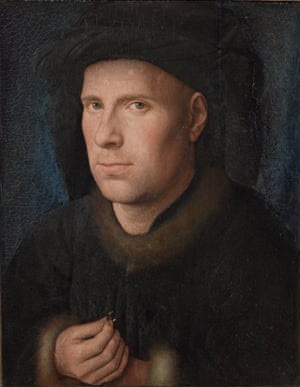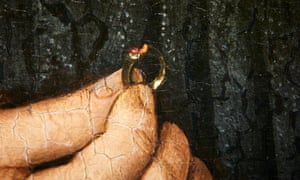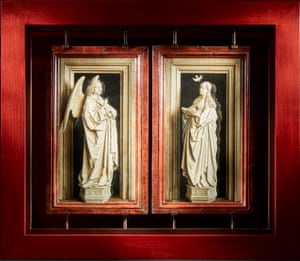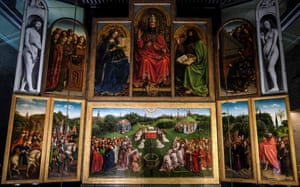Ghent, Belgium
The stupendous restoration of the altarpiece, and the magnificent exhibition nearby, confirm Van Eyck as a painting colossus. Get yourself to Ghent!
A
ccording to the Italian art critic Giorgio Vasari, writing hundreds of miles away and more than a century later, the Flemish painter Jan van Eyck “delighted in alchemy”. As he mixed up compounds by candlelight in a workshop by a canal in Bruges, he hit on the secret of oil painting. There’s no proof of any of this – but as you look at his uncannily perfect paintings in the epochal new survey of his genius at Ghent’s Museum of Fine Arts, it’s easy to believe he dabbled in magic.
The proof twinkles between the thumb and index finger of Jan de Leeuw, in Van Eyck’s 1436 portrait of this fellow craftsman. De Leeuw was a leading Bruges goldsmith and, as he fixes a sharp, clear gaze straight at you, he holds a ring he has made. It’s as much rivalry as homage. The jeweller’s art is intricate, but painting is something else. The ring glints in dazzles of yellow, catching a beam of light. The goldsmith made a reflective object, but Van Eyck has made the light itself.
Making gold from base metal was the alchemist’s dream. Here – in this show at Ghent Museum of Fine Arts, which accompanies the restoration of the Ghent Altarpiece at nearby St Bavo’s Cathedral – Van Eyck makes it from pigments, a trick he performs in ever more spectacular ways like a magician impressing the Duke of Burgundy, for whom he worked as court artist, or doing tricks in the market squares of Bruges and Ghent.
It’s not just gold he can magic into being. In his Annunciation, lent by Washington DC’s National Gallery of Art, the angel Gabriel is bedecked in pearls, rubies and sapphires that are hypnotically solid. The words Gabriel speaks are written in gold in the air. Behind Mary, bottle-glass windows shimmer with light. It’s impossible to resist bending forward to look deeper into the painting’s space. But wait a moment. This is a flat piece of wood with paint on it – not a real room. One thing isn’t really further away than another, it’s all just an illusion.

Van Eyck is a magician all right, and he’s no easier to fathom today than when medieval folk gathered to gawp at his latest impossible creation. One of his favourite feats is to depict stone sculpture, stiller and colder than stone itself – as in his Annunciation Diptych, lent by the Thyssen Museum in Madrid. It works because Van Eyck simulates light hitting the surface of pure white marble and convincingly makes the statues seem three-dimensional, even catching reflections of their far sides in a polished background – and yet, these statues also appear alive. The dove of the holy spirit flies above Mary – but it, too, is stone. Van Eyck is truly showing off his sorcery.
This might all seem like random brilliance, with no guiding beliefs about art and its purpose – except that he left a manifesto for his vision. Van Eyck is thought to have trained as a miniaturist, painting tiny, precise pictures in handwritten manuscripts. You can see, in his portrait of the courtier Baudouin de Lannoy, with his mossy silver stubble over a creased hunk of a face, how he transferred that close eye to portraiture. He was sent on a mission with De Lannoy to portray Isabella of Portugal, so Philip of Burgundy could see his prospective bride – which suggests the court valued him as a kind of photographer before photography. But Van Eyck had grander ideas. You can’t read them in a book. Instead you have to go to St Bavo’s Cathedral to see the Ghent altarpiece.
This mesmerising exhibition celebrates a crucial step in the restoration of the altarpiece, which Van Eyck completed in 1432, six years after his initial collaborator, his brother Hubert, died. Since 2012, the Ghent Museum of Fine Arts has been restoring it, carefully and scientifically, stage by stage. Now the most famous section, the Adoration of the Lamb, has gone back on view after being returned to its original colours and details.
Later re-paintings and mustard-coloured varnish are gone. The acid-blue intensity of the sky and emerald green of the landscape have been set free. Everything is so clear and sharp, now we see it as Van Eyck painted it. The fabulous buildings of his imagined Jerusalem display their geometries, while African and Middle Eastern trees reveal prickles and spikes. Holy processions and angelic hosts gather to revere the Lamb, their faces as wrinkled and characterful as any of his portraits. It’s a painting that pounds with life.
And this is just one part. Meanwhile, other panels have been moved to the exhibition – and these are the true reason to get yourself to Ghent. It can be frustrating to see a “destination” artwork. You book your timed ticket to get a jostled experience of a remote icon. But the Museum of Fine Arts has opened up Ghent’s treasure for a proper look. Adam and Eve, two near life-sized nudes from the altarpiece, are in the show to ogle up close. And they’re stunning. Both have wiry tangles of pubic hair overflowing their fig leaves. These thin, dark filaments float over butter-gold flesh with 3D reality.
It might be a confession. The truth of the human body matters just as much to him as a mystic lamb. The real meaning of the Ghent altarpiece, for its creator, is not religious. It’s about art. Michelangelo would be accused, much later, of glorifying his own art in the Sistine Chapel, instead of God. What Van Eyck does, too, is to declare the freedom of art – and the godlike power of painting. He shows on a stupendous scale that painting can remake worlds. In one panel, a window is open on to a blue, bird-filled sky above a medieval street, where people are chatting as they did 600 years ago. Jan van Eyck has preserved this moment by an act of wizardry.
- Van Eyck: An Optical Revolution is at the Museum of Fine Arts, Ghent, from 1 February until 30 April.
- ==================================================





